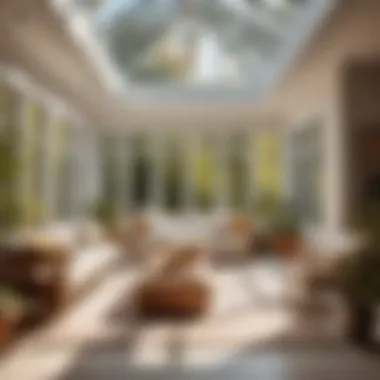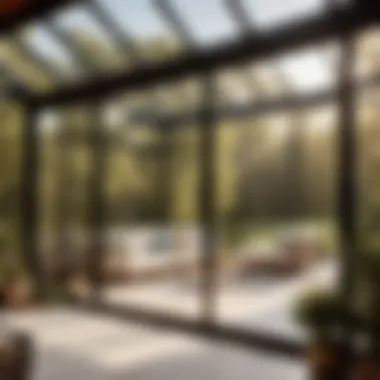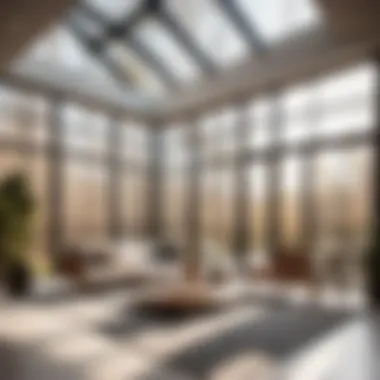Materials:
- Flooring Materials
- Porcelain Tiles: 100 sq. ft
- Floor Adhesive: 1 gallon
- Spacers: 50 pieces
- Grout: 2.5 pounds
- Biophilic Elements
- Hanging Plants: 3 pots
- Wall Vines: 20 feet
- Windows and Doors
- Large Windows: 3 sets
- Sliding Door: 1 set
- Window Tint: 1 roll
- Furniture
- Cozy Armchairs: 2
- Coffee Table: 1
- Lighting Fixtures
- Overhead Lights: 1 set
- Floor Lamp: 1
- Table Lamps: 2
DIY Steps:
-
Prepare the Area: Clear the designated space in your home for the sunroom construction. Ensure the foundation is clean and level.
-
Install Flooring: Lay out the porcelain tiles using spacers for even spacing. Apply floor adhesive and grout for a polished finish.
-
Incorporate Biophilic Elements: Hang plants strategically around the room and install wall vines for a nature-inspired ambiance.
-
Enhance Natural Light: Replace existing windows with large, energy-efficient options. Install a sliding door for easy access to the outdoors.
-
Select Stylish Furniture: Choose comfortable armchairs and a sleek coffee table to create a cozy seating area.
-
Illuminate the Space: Install overhead lights for general lighting, a floor lamp for ambient glow, and table lamps for task lighting.
Technical Aspects:
- Tools Needed: Tile cutter, trowel, grout float, screwdriver, measuring tape.
- Timing Specifics: Allow 2-3 days for flooring installation, 1 day for window and door replacement.
- Critical Techniques: Proper tile alignment, window sealing, and secure furniture arrangement.
DIY Project Process:


-
Installation Method: Start by laying the flooring, then proceed with window and door replacements, adding furniture, and lighting fixtures.
-
Key Techniques:
- Ensure precise measurements for a seamless flooring finish.
- Seal windows and doors properly to prevent energy loss.
- Arrange furniture strategically for a functional layout.
-
Troubleshooting Tips:
- If tiles are misaligned, gently adjust them before the adhesive sets.
- Ensure proper sealing to prevent drafts around windows and doors.
- Opt for adjustable lighting options for flexibility in ambiance.
Utilizing Biophilic Design


Biophilic design is a cutting-edge concept that integrates natural elements into the built environment to create spaces that promote well-being, connection to nature, and a sense of calm. In the context of modern homes, the incorporation of biophilic design principles in sunrooms can elevate the aesthetic appeal and functionality of the space. By seamlessly blending indoor and outdoor elements, biophilic design enhances the overall experience of the sunroom, making it a tranquil retreat within the home. Factors to consider when utilizing biophilic design in sunrooms include the selection of sustainable materials, maximization of natural light, and incorporation of greenery to foster a sense of harmony with nature.
Incorporating Living Walls
Living walls, also known as vertical gardens, are a striking way to introduce biophilic elements into a sunroom. These lush vertical installations offer numerous benefits, such as improved air quality, temperature regulation, and aesthetic enhancement. The benefits of vertical gardens extend beyond their visual appeal; they also promote a healthier indoor environment by reducing pollutants and increasing oxygen levels. Choosing the right plant species is crucial for the success of a living wall. Factors to consider include light requirements, water needs, and growth habits to ensure the longevity and vibrancy of the vertical garden. Maintenance tips for living walls involve regular watering, pruning, and monitoring for pests to sustain the health and beauty of the plant display.
Benefits of Vertical Gardens
Vertical gardens not only serve as a decorative element but also contribute to air purification and insulation, making them a multifunctional addition to modern sunrooms. The key characteristic of vertical gardens lies in their ability to vertically grow plants, maximizing space utilization and offering a unique visual appeal. This feature makes them a popular choice for integrating biophilic design in sunrooms, as they bring a touch of nature indoors while adding a touch of sophistication to the space.
Choosing the Right Plant Species
Selecting the appropriate plant species for a living wall is essential for ensuring the success and longevity of the vertical garden. The key characteristic of choosing the right plant species lies in matching the plants' needs with the sunroom's conditions, such as light levels, temperature, and humidity. This tailored selection is crucial for maintaining a thriving and vibrant vertical garden that complements the overall design of the space.
Maintenance Tips for Living Walls
Proper maintenance is essential to preserve the health and aesthetic appeal of living walls. Regular care, including watering, fertilizing, and keeping an eye out for pests, is vital for ensuring the plants thrive in the indoor environment. Understanding the unique requirements of each plant species in the living wall is key to addressing their specific needs and promoting their well-being in the sunroom.
Optimizing Space and Functionality


Multi-Functional Furniture Solutions
The adoption of multi-functional furniture solutions is a key strategy in optimizing space and functionality within a sunroom setting. By integrating furniture pieces that serve dual purposes, such as convertible seating options, storage integration ideas, and floor space efficiency techniques, homeowners can transform their sunrooms into dynamic and adaptable spaces that seamlessly adapt to different activities and needs. These innovative furniture solutions not only enhance the visual appeal of the sunroom but also contribute to a more organized and clutter-free environment.
-
Convertible Seating Options
Convertible seating options are a crucial element in modern sunroom design, offering versatile seating arrangements that can be easily reconfigured to accommodate varying purposes. The key characteristic of convertible seating lies in its ability to transform from seating to sleeping or lounging surfaces, providing homeowners with flexibility in space utilization. This functionality is particularly beneficial in a sunroom setting where space optimization is essential, allowing for efficient use of available square footage. While convertible seating options enhance the adaptability of the sunroom, they may have some drawbacks related to comfort levels or stability, requiring careful consideration during the selection process.
-
Storage Integration Ideas
Storage integration ideas play a vital role in maximizing space efficiency and maintaining a clutter-free sunroom environment. By incorporating innovative storage solutions such as built-in cabinets, hidden compartments, and under-seat storage, homeowners can effectively utilize every inch of available space while keeping essential items neatly organized and easily accessible. The key characteristic of storage integration lies in its ability to blend seamlessly with the overall design aesthetic while offering hidden storage opportunities that contribute to a streamlined and visually appealing sunroom layout. However, the challenge may arise in balancing storage needs with the aesthetics of the sunroom, as overly prominent storage pieces can detract from the desired look and feel.
-
Maximizing Floor Space Efficiency
Maximizing floor space efficiency is a crucial aspect of optimizing functionality in a sunroom, especially in homes where square footage is limited. By implementing smart layout designs, selecting space-saving furniture, and decluttering unnecessary items, homeowners can create an open and airy ambiance that enhances the overall appeal of the sunroom. The key characteristic of floor space efficiency revolves around creating a sense of spaciousness and freedom of movement within the confined area, allowing for unhindered interaction with the surrounding environment. While maximizing floor space efficiency brings significant advantages in terms of visual appeal and usability, it may pose challenges related to furniture selection and layout optimization, requiring thoughtful planning and design execution.
Innovative Lighting Concepts
In the realm of modern sunroom design, the incorporation of innovative lighting concepts plays a pivotal role in creating a harmonious and inviting atmosphere. The strategic use of lighting not only enhances the aesthetic appeal but also promotes functionality and mood adaptation within the space. When considering sunroom illumination, focusing on distinctive elements like LED strip lighting can elevate the ambiance to a new level of sophistication and comfort.
LED Strip Lighting Effects
Ambient Lighting Techniques:
Ambient lighting techniques involve the strategic placement of LED strip lights to create a soft, diffused glow throughout the sunroom. This gentle illumination mimics natural light patterns, fostering a calming and natural ambiance that aligns perfectly with the biophilic design principles often integrated into modern sunroom spaces. The versatility of ambient lighting allows for the creation of different moods, from cozy evenings to vibrant daytime settings, making it an essential component of a well-rounded lighting concept.
Customizing Colors and Intensities:
Customizing the colors and intensities of LED strip lights provides homeowners with the flexibility to tailor the atmosphere according to their preferences. By adjusting the color temperature and brightness levels, inhabitants can create personalized environments that suit various activities and occasions. Whether opting for warm hues for a cozy feel or bright tones for a lively atmosphere, the ability to customize lighting colors and intensities adds a layer of personalization and comfort to the sunroom space.
Highlighting Architectural Features:
Incorporating LED strip lighting to highlight architectural features within the sunroom can accentuate the unique design elements of the space. By strategically placing lights to emphasize textures, shapes, or focal points, homeowners can draw attention to key aspects of the room's structure or decor. This not only adds visual interest and depth but also elevates the overall aesthetic and sophistication of the sunroom, showcasing its architectural details in a striking and impactful way.
Solar-Powered Lighting Solutions
Exploring solar-powered lighting solutions offers a sustainable and energy-efficient option for illuminating the sunroom while reducing environmental impact. By harnessing the power of the sun, homeowners can enjoy consistent and cost-effective lighting without depending solely on traditional electricity sources. Solar-powered fixtures not only contribute to a greener lifestyle but also enhance the overall sustainability of the home environment.
Benefits of Solar-Powered Fixtures:
Solar-powered fixtures provide an eco-friendly lighting solution that lowers utility costs and reduces carbon footprint. These fixtures enable homeowners to take advantage of renewable energy sources, aligning with modern sustainable practices and eco-conscious living. By investing in solar-powered lighting, residents can enjoy well-lit sunroom spaces while minimizing their environmental impact and contributing to a greener future.
Positioning for Maximum Sun Exposure:
Strategically positioning solar-powered fixtures to maximize sun exposure is essential for optimizing energy efficiency and performance. Ensuring that solar panels receive adequate sunlight throughout the day increases the effectiveness of the lighting system and ensures consistent illumination. By selecting ideal locations and angles for solar fixture placement, homeowners can harness the full power of solar energy to illuminate their sunroom spaces efficiently and sustainably.
Incorporating Motion Sensors:
Incorporating motion sensors into solar-powered lighting solutions adds an element of convenience and energy conservation to the sunroom environment. Motion sensors detect movement within the space, automatically adjusting the lighting levels to meet specific needs. This feature not only enhances safety and security by providing illumination when occupants are present but also conserves energy by minimizing unnecessary light usage. By integrating motion sensors into solar-powered lighting setups, homeowners can enjoy a seamlessly automated lighting experience while optimizing energy efficiency in their sunroom.
Embracing Indoor-Outdoor Connectivity
In the realm of modern home design, the concept of embracing indoor-outdoor connectivity holds paramount importance. Seamless transitions between indoor spaces and the external environment create a harmonious flow that transcends conventional architectural boundaries. By integrating sunrooms with sliding glass wall systems, homeowners can bask in the benefits of a space that seamlessly merges the comfort of indoor living with the beauty of nature. This strategic integration not only enhances the aesthetic appeal of a home but also fosters a sense of openness and tranquility.
Sliding Glass Wall Systems
Advantages of Seamless Transitions
The allure of seamless transitions lies in its ability to dissolve the barriers between indoor and outdoor spaces, offering a fluid connection that invites natural light and ventilation. These transitions elevate the overall ambiance of a sunroom, creating a refreshing environment that blurs the distinction between inside and outside. The key characteristic of seamless transitions is the unobstructed view it provides, allowing homeowners to immerse themselves in the surrounding landscape effortlessly. This design choice proves to be both popular and advantageous for modern homes seeking to embrace nature while maintaining comfort and style. The unique feature of seamless transitions is their capacity to enhance spatial perception, making even compact sunrooms feel more expansive and inviting, a valuable asset for this article.
Choosing Energy-Efficient Glass
Within the realm of modern sunroom design, the selection of energy-efficient glass significantly contributes to the overall sustainability and comfort of the space. Opting for energy-efficient glass minimizes heat transfer, thus regulating indoor temperatures effectively and reducing energy consumption. The key characteristic of energy-efficient glass is its thermal insulation properties, which help maintain a comfortable environment throughout the year. This choice is popular and beneficial for this article as it aligns with the theme of blending innovation with eco-conscious design. Energy-efficient glass also contributes to the aesthetic appeal of a sunroom by offering clarity and durability. While its advantages are notable, considerations of cost and installation should be taken into account for this article.
Maintenance Considerations
In the realm of sunroom design, considering maintenance aspects is crucial to ensure the longevity and functionality of the space. Maintenance considerations encompass regular cleaning and inspection of glass panels, frames, and mechanisms to guarantee smooth operation and optimal performance. The key characteristic of maintenance considerations is their potential to prevent potential issues and preserve the quality of sliding glass wall systems over time. This aspect is a popular and beneficial choice for this article given its emphasis on providing comprehensive guidance to homeowners seeking to incorporate innovative sunroom ideas. The unique feature of addressing maintenance early on is the assurance of continuous enjoyment and utility of the sunroom space, mitigating future challenges effectively. While maintenance may require time and effort, the long-term benefits outweigh the occasional inconveniences for this article.
Integration with Outdoor Landscaping
In the context of creating a seamless indoor-outdoor connection, integrating sunrooms with outdoor landscaping plays a pivotal role in enhancing the overall aesthetic and functionality. By blurring boundaries with greenery, homeowners can extend the natural allure of the surroundings into the sunroom, creating a cohesive design flow that transcends traditional confines. This integration not only adds a touch of serenity and freshness but also amplifies the connection with nature, fostering a holistic living experience.
Blurring Boundaries with Greenery
The essence of blurring boundaries with greenery revolves around merging interior and exterior spaces through strategic placement of plants and foliage. This approach adds a vibrant and organic dimension to the sunroom, creating a seamless fusion between the built environment and nature. The key characteristic of this design element is its ability to rejuvenate the atmosphere, infusing the space with oxygen-rich air and visual appeal. This choice proves to be both beneficial and popular for this article, as it aligns with the emphasis on embracing biophilic characteristics in modern sunroom design. The unique feature of blurring boundaries with greenery is its capacity to enhance mood and well-being, making it a valuable addition to any sunroom setting for this article.
Creating a Harmonious Design Flow
Creating a harmonious design flow between indoor and outdoor spaces is essential for ensuring a cohesive and visually striking sunroom environment. This design aspect focuses on integrating elements such as color palettes, textures, and architectural features to unify the indoor and outdoor aesthetics seamlessly. The key characteristic of harmonious design flow is its ability to create a sense of continuity and balance, establishing a visual connection that enhances the overall appeal of the sunroom. This choice is both beneficial and popular for this article, as it underscores the significance of creating a cohesive and inviting space that reflects a modern lifestyle. The unique feature of harmonious design flow is its potential to elevate the overall look and feel of the sunroom, transforming it into a sanctuary that resonates with nature and style effectively.
Incorporating Outdoor Seating Areas
Incorporating outdoor seating areas within the sunroom setting enriches the living experience by offering a cozy and inviting space to relax and unwind. Outdoor seating areas extend the functionality of the sunroom, providing a versatile space for lounging, reading, or entertaining guests. The key characteristic of outdoor seating areas is their capacity to bridge the gap between indoor comfort and outdoor serenity, offering homeowners a flexible environment to enjoy the beauty of nature. This design choice is popular and beneficial for this article as it promotes the idea of creating a holistic and multi-functional sunroom space. The unique feature of outdoor seating areas is their ability to evoke a sense of alfresco living, allowing homeowners to connect with the outdoors while remaining sheltered within the sunroom's comfort, adding an extra layer of charm and practicality to the overall design for this article.





